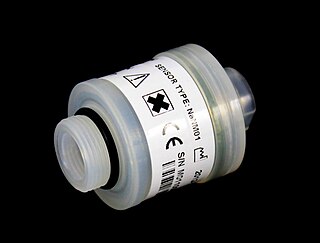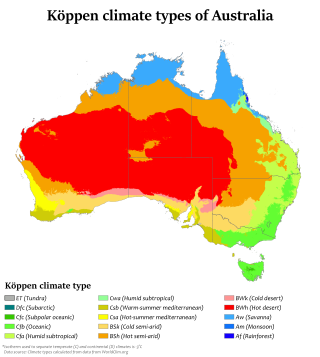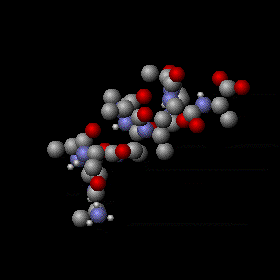Temperature range may refer to:
- Atmospheric temperature
- An aspect of climate classification
- Diurnal temperature variation
- Operating temperature
- Temperature
- Thermal amplitude of the human body
- Thermoregulation
Temperature range may refer to:

A thermocouple, also known as a "thermoelectrical thermometer", is an electrical device consisting of two dissimilar electrical conductors forming an electrical junction. A thermocouple produces a temperature-dependent voltage as a result of the Seebeck effect, and this voltage can be interpreted to measure temperature. Thermocouples are widely used as temperature sensors.

A thermistor is a semiconductor type of resistor whose resistance is strongly dependent on temperature, more so than in standard resistors. The word thermistor is a portmanteau of thermal and resistor.

Weather is the state of the atmosphere, describing for example the degree to which it is hot or cold, wet or dry, calm or stormy, clear or cloudy. On Earth, most weather phenomena occur in the lowest layer of the planet's atmosphere, the troposphere, just below the stratosphere. Weather refers to day-to-day temperature, precipitation, and other atmospheric conditions, whereas climate is the term for the averaging of atmospheric conditions over longer periods of time. When used without qualification, "weather" is generally understood to mean the weather of Earth.
Saturation, saturated, unsaturation or unsaturated may refer to:
Cold-blooded is an informal term for one or more of a group of characteristics that determine an animal's thermophysiology. These include:

Death Valley is a desert valley in Eastern California, in the northern Mojave Desert, bordering the Great Basin Desert. During summer, it is thought to be the hottest place on Earth. Death Valley is home to the Timbisha tribe of Native Americans, formerly known as the Panamint Shoshone, who have inhabited the valley for at least the past millennium.

Humidity is the concentration of water vapor present in the air. Water vapor, the gaseous state of water, is generally invisible to the human eye. Humidity indicates the likelihood for precipitation, dew, or fog to be present.
Standard atmosphere may refer to:

Colloquially, room temperature is a range of air temperatures that most people prefer for indoor settings. It feels comfortable to a person when they are wearing typical indoor clothing. Human comfort can extend beyond this range depending on humidity, air circulation and other factors. Food or beverages may be served at room temperature, meaning neither heated nor cooled.

A hydraulic fluid or hydraulic liquid is the medium by which power is transferred in hydraulic machinery. Common hydraulic fluids are based on mineral oil or water. Examples of equipment that might use hydraulic fluids are excavators and backhoes, hydraulic brakes, power steering systems, automatic transmissions, garbage trucks, aircraft flight control systems, lifts, and industrial machinery.

AccuWeather Inc. is an American media company that provides commercial weather forecasting services worldwide.
Degree may refer to:

An electro-galvanic fuel cell is an electrochemical device which consumes a fuel to produce an electrical output by a chemical reaction. One form of electro-galvanic fuel cell based on the oxidation of lead is commonly used to measure the concentration of oxygen gas in underwater diving and medical breathing gases.
Hardiness of plants describes their ability to survive adverse growing conditions. It is usually limited to discussions of climatic adversity. Thus a plant's ability to tolerate cold, heat, drought, flooding, or wind are typically considered measurements of hardiness. Hardiness of plants is defined by their native extent's geographic location: longitude, latitude and elevation. These attributes are often simplified to a hardiness zone. In temperate latitudes, the term most often describes resistance to cold, or "cold-hardiness", and is generally measured by the lowest temperature a plant can withstand.

The International Temperature Scale of 1990 (ITS-90) is an equipment calibration standard specified by the International Committee of Weights and Measures (CIPM) for making measurements on the Kelvin and Celsius temperature scales. It is an approximation of thermodynamic temperature that facilitates the comparability and compatibility of temperature measurements internationally. It defines fourteen calibration points ranging from 0.65 K to 1357.77 K and is subdivided into multiple temperature ranges which overlap in some instances. ITS-90 is the most recent of a series of International Temperature Scales adopted by the CIPM since 1927. Adopted at the 1989 General Conference on Weights and Measures, it supersedes the International Practical Temperature Scale of 1968 and the 1976 "Provisional 0.5 K to 30 K Temperature Scale". The CCT has also published several online guidebooks to aid realisations of the ITS-90. The lowest temperature covered by the ITS-90 is 0.65 K. In 2000, the temperature scale was extended further, to 0.9 mK, by the adoption of a supplemental scale, known as the Provisional Low Temperature Scale of 2000 (PLTS-2000).
Normal human body-temperature is the typical temperature range found in humans. The normal human body temperature range is typically stated as 36.5–37.5 °C (97.7–99.5 °F).

Australia's climate is governed mostly by its size and by the hot, sinking air of the subtropical high pressure belt. This moves north-west and north-east with the seasons. The climate is variable, with frequent droughts lasting several seasons, thought to be caused in part by the El Niño-Southern Oscillation. Australia has a wide variety of climates due to its large geographical size. The largest part of Australia is desert or semi-arid. Only the south-east and south-west corners have a temperate climate and moderately fertile soil. The northern part of the country has a tropical climate, varying between grasslands and desert. Australia holds many heat-related records: the continent has the hottest extended region year-round, the areas with the hottest summer climate, and the highest sunshine duration.

Gas is one of the four fundamental states of matter. The others are solid, liquid, and plasma.

Temperature is a physical quantity that expresses quantitatively the perceptions of hotness and coldness. Temperature is measured with a thermometer.
An operating temperature is the allowable temperature range of the local ambient environment at which an electrical or mechanical device operates. The device will operate effectively within a specified temperature range which varies based on the device function and application context, and ranges from the minimum operating temperature to the maximum operating temperature. Outside this range of safe operating temperatures the device may fail.